1973
|
| Berghe, Louis Vanden: Excavations in Luristan Kalleh Nisar. In: Bulletin of the Asia Institute, vol. 3, pp. 25-46, 1973. @article{nokey,
title = {Excavations in Luristan Kalleh Nisar},
author = {Louis Vanden Berghe
},
url = {https://dipot.ulb.ac.be/dspace/bitstream/2013/252064/4/31231de0-1608-440a-b365-6953c26cc58a.txt
},
year = {1973},
date = {1973-01-01},
journal = {Bulletin of the Asia Institute},
volume = {3},
pages = {25-46},
publisher = {Bulletin of the Asia Institute},
keywords = {},
pubstate = {published},
tppubtype = {article}
}
|
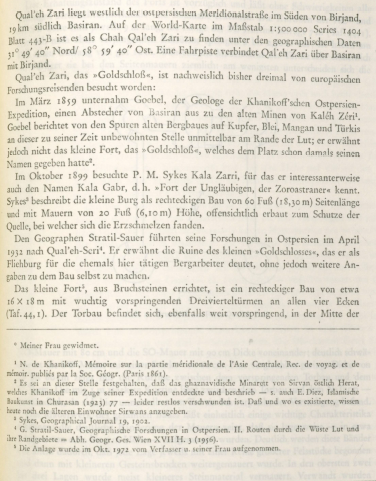 | Hallier, Ulrich W.: Qual'eh Zari, ein prä-islamisches Fort in Ostpersien. In: Archäologische Mitteilungen aus Iran, vol. N.F.6, pp. 189-196, 1973. @article{nokey,
title = {Qual'eh Zari, ein prä-islamisches Fort in Ostpersien},
author = {Ulrich W. Hallier},
year = {1973},
date = {1973-00-00},
urldate = {1973-00-00},
journal = {Archäologische Mitteilungen aus Iran},
volume = {N.F.6},
pages = {189-196},
publisher = {Reimer},
keywords = {},
pubstate = {published},
tppubtype = {article}
}
|
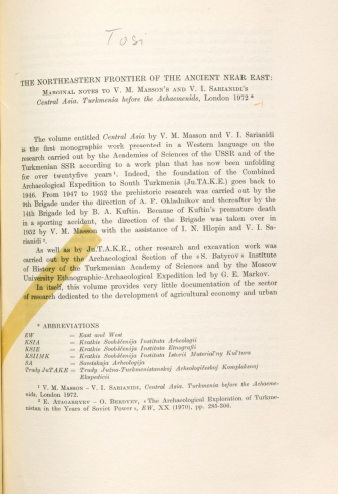 | Tosi, Maurizio: The Northeastern frontier of the ancient Near East. In: Mesopotamia, vol. 8/9, pp. 21-76, 1973. @article{nokey,
title = {The Northeastern frontier of the ancient Near East},
author = {Maurizio Tosi},
year = {1973},
date = {1973-00-00},
urldate = {1973-00-00},
journal = {Mesopotamia},
volume = {8/9},
pages = {21-76},
publisher = {Giapichelli},
keywords = {},
pubstate = {published},
tppubtype = {article}
}
|
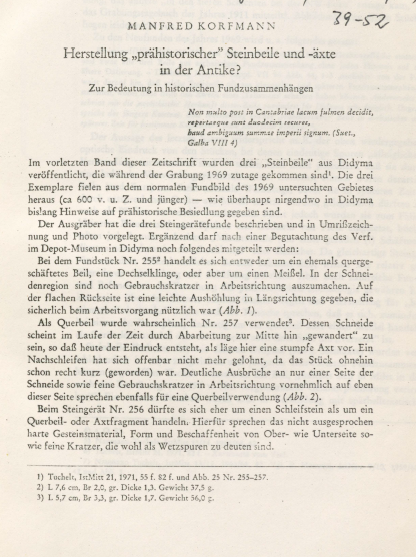 | Korfmann, Manfred: Herstellung "prähistorischer" Steibeile und -äxte in der Antike?. In: Istanbuler Mitteilungen, vol. 23/24, pp. 39-52, 1973. @article{nokey,
title = {Herstellung "prähistorischer" Steibeile und -äxte in der Antike?},
author = {Manfred Korfmann},
year = {1973},
date = {1973-00-00},
urldate = {1973-00-00},
journal = {Istanbuler Mitteilungen},
volume = {23/24},
pages = {39-52},
publisher = {Deutscher Verlag für Kunstwissenschaft},
keywords = {},
pubstate = {published},
tppubtype = {article}
}
|
 | Tosi, Maurizio; Piperno, Marcello: Lithic technology behind the ancient lapis lazuli trade. In: Expedition, vol. 16, iss. 1, pp. 15-23, 1973. @article{nokey,
title = {Lithic technology behind the ancient lapis lazuli trade},
author = {Maurizio Tosi and Marcello Piperno},
url = {https://www.penn.museum/documents/publications/expedition/PDFs/16-1/Tosi.pdf},
year = {1973},
date = {1973-00-00},
urldate = {1973-00-00},
journal = {Expedition},
volume = {16},
issue = {1},
pages = {15-23},
keywords = {},
pubstate = {published},
tppubtype = {article}
}
|
![Geschichte der Perser und Araber zur Zeit der Sasaniden. Aus der arabischen Chronik des Tabari übersetzt und mit ausführlichen Erläuterungen und Ergänzungen versehn [excerpt]](https://iranhighlands.com/wp-content/uploads/2022/11/055.png) | aṭ-Ṭabarī, Muḥammad Ibn-Ǧarīr; Nöldeke, Th.: Geschichte der Perser und Araber zur Zeit der Sasaniden. Aus der arabischen Chronik des Tabari übersetzt und mit ausführlichen Erläuterungen und Ergänzungen versehn [excerpt]. Brill Publishers, 1973, ISBN: 978-90-04-03624-6. @book{nokey,
title = {Geschichte der Perser und Araber zur Zeit der Sasaniden. Aus der arabischen Chronik des Tabari übersetzt und mit ausführlichen Erläuterungen und Ergänzungen versehn [excerpt]},
author = {Muḥammad Ibn-Ǧarīr aṭ-Ṭabarī and Th. Nöldeke},
url = {https://brill.com/view/title/1900?language=de},
isbn = {978-90-04-03624-6},
year = {1973},
date = {1973-00-00},
urldate = {1973-00-00},
publisher = {Brill Publishers},
keywords = {},
pubstate = {published},
tppubtype = {book}
}
|
| Hallier, Ulrich W.: Qual'eh Tari, ein prä-islamisches Fort in Ostpersien. In: Archäologische Mitteilungen aus Iran, vol. 6, pp. 189-196, 1973. @article{nokey,
title = {Qual'eh Tari, ein prä-islamisches Fort in Ostpersien},
author = {Ulrich W. Hallier},
year = {1973},
date = {1973-00-00},
journal = {Archäologische Mitteilungen aus Iran},
volume = {6},
pages = {189-196},
publisher = {Reimer},
keywords = {},
pubstate = {published},
tppubtype = {article}
}
|
| Schumacher, Erich: Eisenschwerter mit Maskenzier aus Luristan. In: Bonner Hefte zur Vorgeschichte, no. 4, pp. 97-108, 1973. @article{nokey,
title = {Eisenschwerter mit Maskenzier aus Luristan},
author = {Erich Schumacher
},
year = {1973},
date = {1973-00-00},
urldate = {1973-00-00},
journal = {Bonner Hefte zur Vorgeschichte},
number = {4},
pages = {97-108},
publisher = {Universiät Bonn},
keywords = {},
pubstate = {published},
tppubtype = {article}
}
|
| Tosi, Maurizio; Piperno, Marcello: Lithic Technology Behind the Ancient Lapis Lazuli Trade. In: Expedition, vol. 16, no. 1, pp. 15-23, 1973. @article{nokey,
title = {Lithic Technology Behind the Ancient Lapis Lazuli Trade},
author = {Maurizio Tosi and Marcello Piperno
},
url = {https://www.penn.museum/documents/publications/expedition/16-1/Tosi.pdf
},
year = {1973},
date = {1973-00-00},
journal = {Expedition},
volume = {16},
number = {1},
pages = {15-23},
publisher = {Penn Museum},
keywords = {},
pubstate = {published},
tppubtype = {article}
}
|
| Shafighi, C.: Die Erzvorkommen im Gebiet von Ahangaran (b. Malayer, Iran). 1973. @phdthesis{nokey,
title = {Die Erzvorkommen im Gebiet von Ahangaran (b. Malayer, Iran)},
author = {C. Shafighi
},
year = {1973},
date = {1973-00-00},
address = {Bern},
keywords = {},
pubstate = {published},
tppubtype = {phdthesis}
}
|
1972
|
| Berghe, Louis Vanden: Recherches archéologiques dans le Luristan: Cinquième campagne :1969. Prospections dans le pusht-i kuh central (rapport préliminaire). In: Iranica Antiqua, vol. 9, pp. 1–48, 1972. @article{nokey,
title = {Recherches archéologiques dans le Luristan: Cinquième campagne :1969. Prospections dans le pusht-i kuh central (rapport préliminaire)},
author = {Louis Vanden Berghe
},
url = {https://dipot.ulb.ac.be/dspace/bitstream/2013/252062/4/1c5fe0d9-12b8-440b-938a-19b6c480b2b5.txt
},
year = {1972},
date = {1972-01-01},
journal = {Iranica Antiqua},
volume = {9},
pages = {1–48},
publisher = {Peeters},
keywords = {},
pubstate = {published},
tppubtype = {article}
}
|
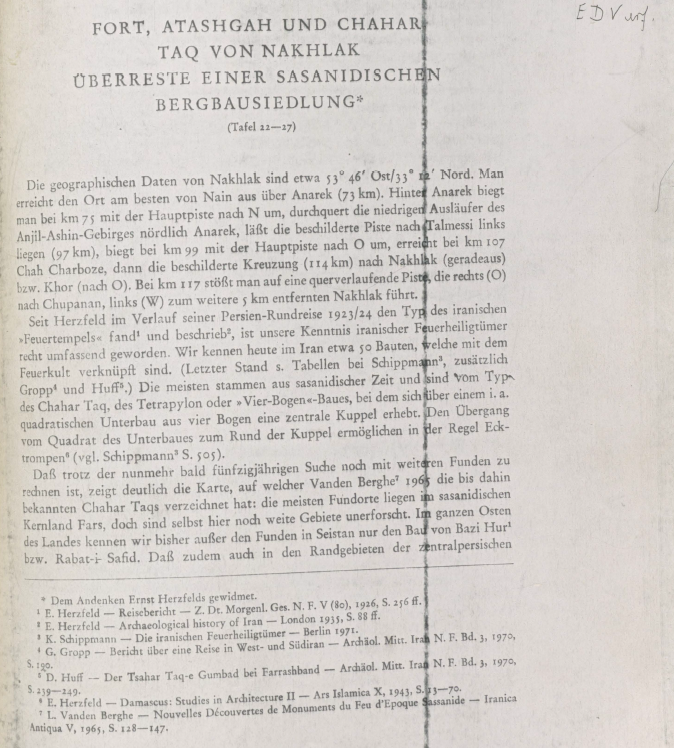 | Hallier, Ulrich W.: Fort, Atashgah und Chahar Taq von Nakhlak, Überreste einer Sasanidischen Bergbausiedlung. In: Archäologische Mitteilungen aus Iran, vol. N.F. 5, pp. 285-307, 1972. @article{nokey,
title = {Fort, Atashgah und Chahar Taq von Nakhlak, Überreste einer Sasanidischen Bergbausiedlung},
author = {Ulrich W. Hallier},
year = {1972},
date = {1972-00-00},
urldate = {1972-00-00},
journal = {Archäologische Mitteilungen aus Iran},
volume = {N.F. 5},
pages = {285-307},
publisher = {Reimer},
keywords = {},
pubstate = {published},
tppubtype = {article}
}
|
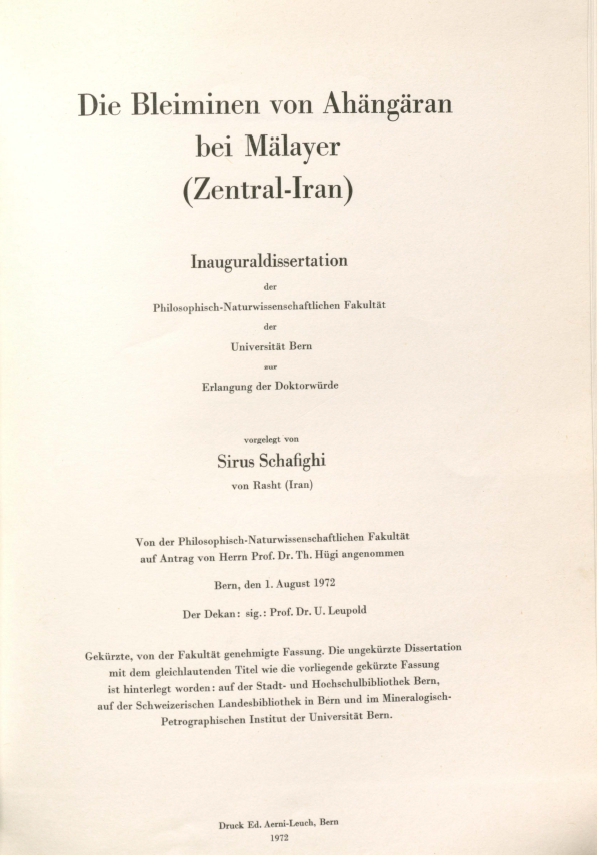 | Schafighi, Sirius: Die Bleiminien von Ahängäran bei Mälazer (Zentral-Iran). 1972. @phdthesis{nokey,
title = {Die Bleiminien von Ahängäran bei Mälazer (Zentral-Iran)},
author = {Sirius Schafighi},
year = {1972},
date = {1972-00-00},
urldate = {1972-00-00},
howpublished = {Bern},
keywords = {},
pubstate = {published},
tppubtype = {phdthesis}
}
|
| Troll, Carl; Braun, Cornel: Madrid - Die Wasserversorgung der Stadt durch Qanate im laufe der Geschichte. In: "Akademie der Wissenschaften und der Literatur. Abhandlungen der Mathematisch-Naturwissenschaftlichen Klasse 1972", no. 5, pp. 102-186, 1972. @article{nokey,
title = {Madrid - Die Wasserversorgung der Stadt durch Qanate im laufe der Geschichte},
author = {Carl Troll and Cornel Braun
},
year = {1972},
date = {1972-00-00},
journal = {"Akademie der Wissenschaften und der Literatur. Abhandlungen der Mathematisch-Naturwissenschaftlichen Klasse 1972"},
number = {5},
pages = {102-186},
publisher = {Steiner},
keywords = {},
pubstate = {published},
tppubtype = {article}
}
|
| Hallier, Ulrich W.: Fort, Atashgah und Chahar Taq von Nakhlak, Überreste einer sasanidischen Bergbausiedlung. In: Archäologische Mitteilungen aus Iran, vol. 5, pp. 285-307, 1972. @article{nokey,
title = {Fort, Atashgah und Chahar Taq von Nakhlak, Überreste einer sasanidischen Bergbausiedlung},
author = {Ulrich W. Hallier
},
year = {1972},
date = {1972-00-00},
journal = {Archäologische Mitteilungen aus Iran},
volume = {5},
pages = {285-307},
publisher = {Reimer},
keywords = {},
pubstate = {published},
tppubtype = {article}
}
|
| O'Kane, John: The Ship of Sulaiman. In: Persian Heritage Series, vol. 11, pp. 28-31; 174-175, 1972. @article{nokey,
title = {The Ship of Sulaiman},
author = {John O'Kane
},
year = {1972},
date = {1972-00-00},
journal = {Persian Heritage Series},
volume = {11},
pages = {28-31; 174-175},
publisher = {Routledge & Paul},
keywords = {},
pubstate = {published},
tppubtype = {article}
}
|
| Boehmer, R. M.: Die Kleinfunde von Bogazkoy aus den Grabungskampagnen 1931-1939 und 1952-1969. Mann, 1972. @book{nokey,
title = {Die Kleinfunde von Bogazkoy aus den Grabungskampagnen 1931-1939 und 1952-1969},
author = {R. M. Boehmer
},
year = {1972},
date = {1972-00-00},
publisher = {Mann},
series = {Boğazköy-Ḫattus̆a},
keywords = {},
pubstate = {published},
tppubtype = {book}
}
|
1971
|
| Berghe, Louis Vanden: Excavations in Pusht-i Kuh (Iran) Tombs Provide Evidence of Dating "Typical Luristan Bronzes". In: Archaeology, vol. 24, no. 3, pp. 263-271, 1971. @article{nokey,
title = {Excavations in Pusht-i Kuh (Iran) Tombs Provide Evidence of Dating "Typical Luristan Bronzes"},
author = {Louis Vanden Berghe},
url = {https://www.jstor.org/stable/41674325},
year = {1971},
date = {1971-06-01},
issuetitle = {A special issue highlighting ISLAMIC ARCHAEOLOGY (JUNE 1971)},
journal = {Archaeology},
volume = {24},
number = {3},
pages = {263-271},
publisher = {Archaeological Institute of America},
keywords = {},
pubstate = {published},
tppubtype = {article}
}
|
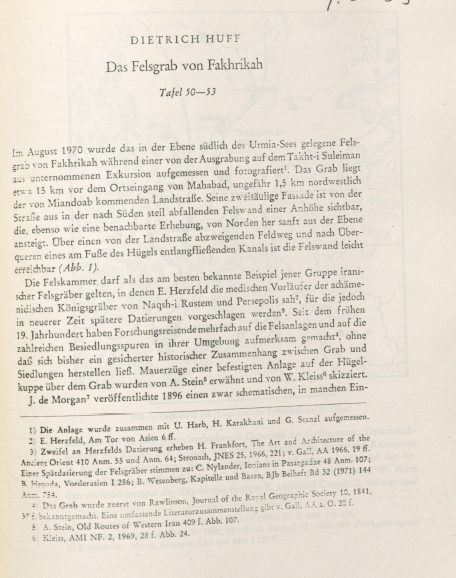 | Huff, Dietrich: Das Felsgrab von Fakhrikah. In: Istanbuler Mitteilungen, vol. 21, pp. 161-171, 1971. @article{nokey,
title = {Das Felsgrab von Fakhrikah},
author = {Dietrich Huff},
year = {1971},
date = {1971-00-00},
urldate = {1971-00-00},
journal = {Istanbuler Mitteilungen},
volume = {21},
pages = {161-171},
publisher = {Deutscher Verlag für Kunstwissenschaft},
keywords = {},
pubstate = {published},
tppubtype = {article}
}
|
 | Ehlers, Eckart: Klimageschichte und Siedlungsgang in vor- und frühgeschichtlicher Zeit in der Turkmenensteppe Nordpersiens. In: Archäologische Mitteilungen aus Iran, no. 4, pp. 7-19, 1971. @article{nokey,
title = {Klimageschichte und Siedlungsgang in vor- und frühgeschichtlicher Zeit in der Turkmenensteppe Nordpersiens},
author = {Eckart Ehlers},
year = {1971},
date = {1971-00-00},
journal = {Archäologische Mitteilungen aus Iran},
number = {4},
pages = {7-19},
publisher = {Reimer},
keywords = {},
pubstate = {published},
tppubtype = {article}
}
|
| Holzer, Herwig F.; Momenzadeh, Morteza: Ancient Copper Mines in the Veshnoveh Area, Kuhestan-E-Qom, West-Central Iran. In: Archaeologia Austriaca, vol. 49, pp. 1-22, 1971. @article{nokey,
title = {Ancient Copper Mines in the Veshnoveh Area, Kuhestan-E-Qom, West-Central Iran},
author = {Herwig F. Holzer and Morteza Momenzadeh
},
year = {1971},
date = {1971-00-00},
journal = {Archaeologia Austriaca},
volume = {49},
pages = {1-22},
publisher = {Austrian Academy of Sciences Press},
keywords = {},
pubstate = {published},
tppubtype = {article}
}
|
| Ehlers, Eckart: Klimageschichte und Siedlungsgang in vor- und frühgeschichtlicher Zeit in der Turkmenensteppe Nordpersiens. In: Archäologische Mitteilungen aus Iran, vol. 4, pp. 7-19, 1971. @article{nokey,
title = {Klimageschichte und Siedlungsgang in vor- und frühgeschichtlicher Zeit in der Turkmenensteppe Nordpersiens},
author = {Eckart Ehlers},
year = {1971},
date = {1971-00-00},
journal = {Archäologische Mitteilungen aus Iran},
volume = {4},
pages = {7-19},
publisher = {Reimer},
keywords = {},
pubstate = {published},
tppubtype = {article}
}
|
| Berghe, Louis Vanden: Luristan, La Necropole de Bard-I Bal. In: Archéologia, vol. 43, pp. 14-23, 1971. @article{nokey,
title = {Luristan, La Necropole de Bard-I Bal},
author = {Louis Vanden Berghe
},
year = {1971},
date = {1971-00-00},
journal = {Archéologia},
volume = {43},
pages = {14-23},
publisher = {Éditions Faton},
keywords = {},
pubstate = {published},
tppubtype = {article}
}
|
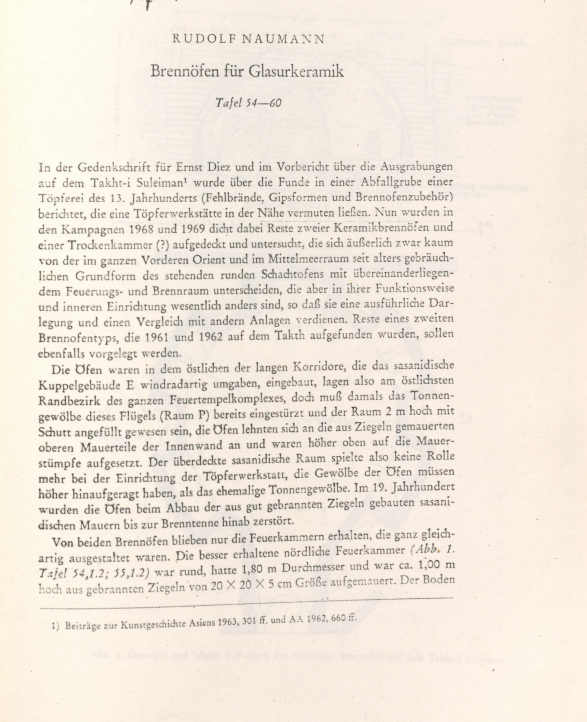 | Naumann, Rudolf: Brennöfen für Glasurkeramik . In: Istanbuler Mitteilungen, vol. 21, pp. 173-190, 1971. @article{nokey,
title = {Brennöfen für Glasurkeramik },
author = {Rudolf Naumann
},
year = {1971},
date = {1971-00-00},
journal = {Istanbuler Mitteilungen},
volume = {21},
pages = {173-190},
publisher = {Deutsches Archäologisches Institut},
keywords = {},
pubstate = {published},
tppubtype = {article}
}
|
| Waldbaum, Jane C.: A bronze and iron Iranian axe in the Fogg Art Museum. In: Mitten, David Gordon; Pedley, John Griffiths (Ed.): Studies presented to George M.A. Hanfmann
, pp. 197-205, P. von Zabern, 1971. @inbook{nokey,
title = {A bronze and iron Iranian axe in the Fogg Art Museum},
author = {Jane C. Waldbaum
},
editor = {David Gordon Mitten and John Griffiths Pedley
},
year = {1971},
date = {1971-00-00},
booktitle = {Studies presented to George M.A. Hanfmann
},
pages = {197-205},
publisher = {P. von Zabern},
series = {Monographs in art and archaeology},
keywords = {},
pubstate = {published},
tppubtype = {inbook}
}
|
1970
|
| Lamberg-Karlovsky, C. C.; Meadow, R. H.: A Unique Female Figurine: the Neolithic at Tepe Yahya. In: Archaeology, vol. 23, no. 1, pp. 12–17, 1970. @article{nokey,
title = {A Unique Female Figurine: the Neolithic at Tepe Yahya},
author = {C. C. Lamberg-Karlovsky and R. H. Meadow},
url = {https://www.jstor.org/stable/41668053},
year = {1970},
date = {1970-01-01},
journal = {Archaeology},
volume = {23},
number = {1},
pages = {12–17},
publisher = {Archaeological Institute of America},
keywords = {},
pubstate = {published},
tppubtype = {article}
}
|
 | Hansen, Donald; Lefferts, Kate C.; Alexander, S. M.: A Proto-Elamite Silver Figurine in the Metropolitan Museum of Art. In: Metropolitan Museum Journal, vol. 3, pp. 05–23, 1970. @article{nokey,
title = {A Proto-Elamite Silver Figurine in the Metropolitan Museum of Art},
author = {Donald Hansen and Kate C. Lefferts and S. M. Alexander},
doi = {https://doi.org/10.2307/1512596},
year = {1970},
date = {1970-01-01},
urldate = {1970-01-01},
journal = {Metropolitan Museum Journal},
volume = {3},
pages = {05–23},
publisher = {The University of Chicago Press},
keywords = {},
pubstate = {published},
tppubtype = {article}
}
|
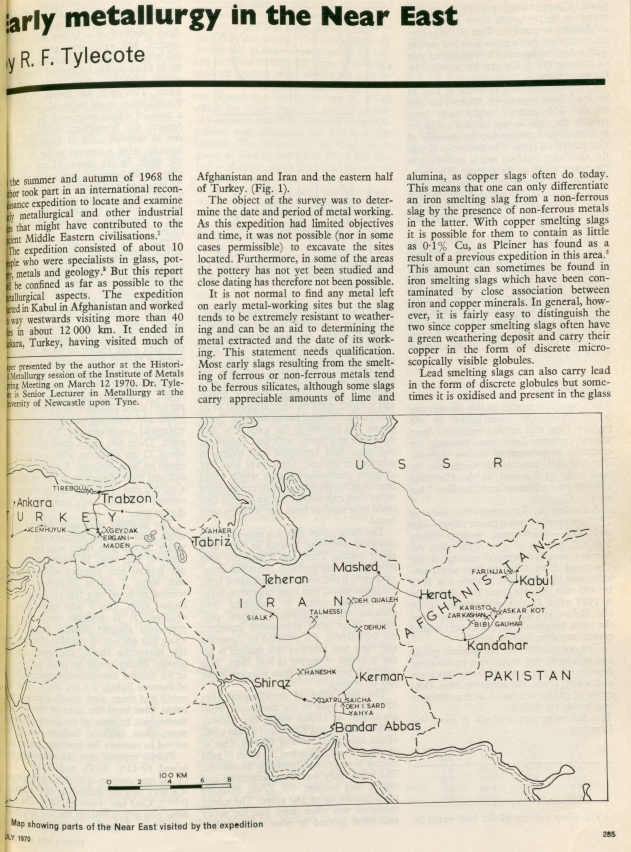 | Tylecote, R. F.: Early metallurgy in the Near East. In: Metals and Materials, pp. 285-293, 1970. @article{nokey,
title = {Early metallurgy in the Near East},
author = {R.F. Tylecote},
year = {1970},
date = {1970-00-00},
urldate = {1970-00-00},
journal = {Metals and Materials},
pages = {285-293},
publisher = {Springer},
keywords = {},
pubstate = {published},
tppubtype = {article}
}
|
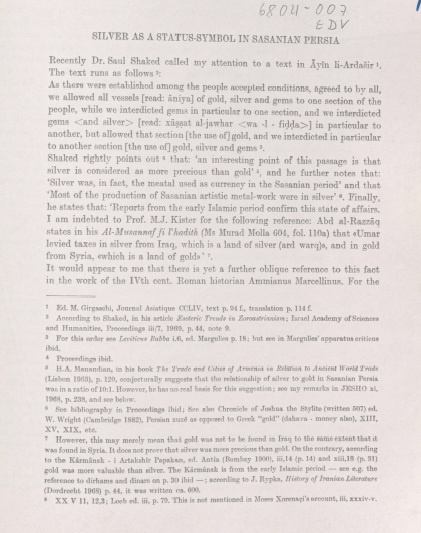 | Sperber, Daniel: Silver as a status-symbol in Sasanian Persia. In: Persica, vol. 5, pp. 103-105, 1970. @article{nokey,
title = {Silver as a status-symbol in Sasanian Persia},
author = {Daniel Sperber},
year = {1970},
date = {1970-00-00},
urldate = {1970-00-00},
journal = {Persica},
volume = {5},
pages = {103-105},
publisher = {Peeters Publishers},
keywords = {},
pubstate = {published},
tppubtype = {article}
}
|
| Bailey, Edgar Herbert: Geology and ore deposits of the Lakan lead-zinc district, Iran. In: Volume 3 of CENTO Training Program in Geological Mapping Techniques
, pp. 5–24, 1970. @inbook{nokey,
title = {Geology and ore deposits of the Lakan lead-zinc district, Iran},
author = {Edgar Herbert Bailey
},
year = {1970},
date = {1970-00-00},
urldate = {1970-00-00},
booktitle = {Volume 3 of CENTO Training Program in Geological Mapping Techniques
},
pages = {5–24},
keywords = {},
pubstate = {published},
tppubtype = {inbook}
}
|
1969
|
| Lamberg-Karlovsky, C. C.: Further Notes on the Shaft-Hole Pick-Axe from Khurāb, Makrān. In: Iran, vol. 7, pp. 163-168, 1969. @article{nokey,
title = {Further Notes on the Shaft-Hole Pick-Axe from Khurāb, Makrān},
author = {C. C. Lamberg-Karlovsky
},
url = {https://www.jstor.org/stable/4299621
},
doi = {https://doi.org/10.2307/4299621},
year = {1969},
date = {1969-01-01},
journal = {Iran},
volume = {7},
pages = {163-168},
publisher = {Taylor and Francis},
keywords = {},
pubstate = {published},
tppubtype = {article}
}
|
| Bazin, Dominique; Hübner, Helmuth: La région cuprifère à gisements porphyriques de Kerman (Iran). In: Mineralium Deposita, vol. 4, pp. 200-212, 1969. @article{nokey,
title = {La région cuprifère à gisements porphyriques de Kerman (Iran)},
author = {Dominique Bazin and Helmuth Hübner},
doi = {10.1007/BF00208052},
year = {1969},
date = {1969-01-01},
journal = {Mineralium Deposita},
volume = {4},
pages = {200-212},
publisher = {Springer Science + Business Media},
keywords = {},
pubstate = {published},
tppubtype = {article}
}
|
 | France-Lanord, Albert: Le fer en Iran au premier millénair avant Jesus-Christ. In: Revue d'histoire des Mines et de la Metallurgie, vol. 1, iss. 1, 1969. @article{nokey,
title = {Le fer en Iran au premier millénair avant Jesus-Christ},
author = {Albert France-Lanord},
year = {1969},
date = {1969-00-00},
urldate = {1969-00-00},
journal = {Revue d'histoire des Mines et de la Metallurgie},
volume = {1},
issue = {1},
publisher = {Centre de Recherches de l'Histoire de la Siderurgie},
keywords = {},
pubstate = {published},
tppubtype = {article}
}
|
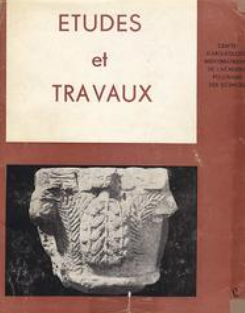 | Mierzejewski, Antoni: Remarques sur les catégories fonctionnelles des martels en bronze du Louristan. In: vol. 3, pp. 17-35, Centre D'Archeologie Mediterraneenne de L'Academie Polonaises des Sciences, 1969. @inbook{nokey,
title = {Remarques sur les catégories fonctionnelles des martels en bronze du Louristan},
author = {Antoni Mierzejewski},
year = {1969},
date = {1969-00-00},
urldate = {1969-00-00},
journal = {Etudes et Travaux},
volume = {3},
pages = {17-35},
publisher = {Centre D'Archeologie Mediterraneenne de L'Academie Polonaises des Sciences},
keywords = {},
pubstate = {published},
tppubtype = {inbook}
}
|
 | Moorey, P. R. S.: Prehistoric copper and bronze metallurgy in western Iran (with special reference to Luristan). In: Iran, vol. 7, pp. 131-154, 1969. @article{nokey,
title = {Prehistoric copper and bronze metallurgy in western Iran (with special reference to Luristan)},
author = {P.R.S. Moorey},
doi = {https://doi.org/10.2307/4299618},
year = {1969},
date = {1969-00-00},
urldate = {1969-00-00},
journal = {Iran},
volume = {7},
pages = {131-154},
publisher = {Taylor & Francis, Ltd.},
keywords = {},
pubstate = {published},
tppubtype = {article}
}
|
 | von Petrikovits, Harald: Die Herkunft einer sasanidischen Silberflaschenform. In: Trierer Zeitschrift, vol. 32, pp. 323-332, 1969. @article{nokey,
title = {Die Herkunft einer sasanidischen Silberflaschenform},
author = {Harald von Petrikovits},
year = {1969},
date = {1969-00-00},
urldate = {1969-00-00},
journal = {Trierer Zeitschrift},
volume = {32},
pages = {323-332},
keywords = {},
pubstate = {published},
tppubtype = {article}
}
|
| Lambton, Ann K. S.: The Persian land reform 1962-1966 (excerpt). Clarendon Press, Oxford, 1969. @book{nokey,
title = {The Persian land reform 1962-1966 (excerpt)},
author = {Ann K. S. Lambton
},
year = {1969},
date = {1969-00-00},
volume = {69},
number = {1},
pages = {274-290, 384},
publisher = {Clarendon Press},
address = {Oxford},
keywords = {},
pubstate = {published},
tppubtype = {book}
}
|
| Schwarz, Paul: Bodenschätze und Gewerbfleiss. In: Iran im Mittelalter
, pp. 185-195, Olms, 1969. @inbook{nokey,
title = {Bodenschätze und Gewerbfleiss},
author = {Paul Schwarz
},
year = {1969},
date = {1969-00-00},
urldate = {1969-00-00},
booktitle = {Iran im Mittelalter
},
pages = {185-195},
publisher = {Olms},
keywords = {},
pubstate = {published},
tppubtype = {inbook}
}
|
1968
|
| Lamberg-Karlovsky, C. C.; Humphries, James: The Cairn Burials of Southeastern Iran. In: East and West, vol. 18, no. 3/4, pp. 269-276, 1968. @article{nokey,
title = {The Cairn Burials of Southeastern Iran},
author = {C.C. Lamberg-Karlovsky and James Humphries
},
url = {https://www.jstor.org/stable/29755332
},
year = {1968},
date = {1968-12-01},
journal = {East and West},
volume = {18},
number = {3/4},
pages = {269-276},
publisher = {ISMEO (International Association for Mediterranean and Oriental Studies)},
keywords = {},
pubstate = {published},
tppubtype = {article}
}
|
| de Cardi, Beatrice: Excavations at Bampūr, S.E. Iran: A Brief Report. In: Iran, vol. 6, pp. 135-155, 1968. @article{nokey,
title = {Excavations at Bampūr, S.E. Iran: A Brief Report},
author = {Beatrice de Cardi
},
url = {https://www.jstor.org/stable/4299605
},
doi = {https://doi.org/10.2307/4299605},
year = {1968},
date = {1968-01-01},
urldate = {1968-01-01},
journal = {Iran},
volume = {6},
pages = {135-155},
publisher = {Taylor and Francis},
keywords = {},
pubstate = {published},
tppubtype = {article}
}
|
 | Caldwell, Joseph R.: Pottery and Cultural History on the Iranian Plateau. In: Journal of Near Eastern Studies, vol. 27, no. 3, pp. 178-183, 1968. @article{nokey,
title = {Pottery and Cultural History on the Iranian Plateau},
author = {Joseph R. Caldwell},
url = {https://www.jstor.org/stable/543533},
doi = {https://doi.org/10.1086/371962},
year = {1968},
date = {1968-00-00},
urldate = {1967-00-00},
journal = {Journal of Near Eastern Studies},
volume = {27},
number = {3},
pages = {178-183},
publisher = {University of Chicago Press},
abstract = {This essay is intended to illustrate the point of you with some evidence that something of the archaeology of the vast area of the Iranian plateau can be learnt by attending to the boundaries of cultural influences as indicated by pottery similarities and differences at successive times. It is assumed that there must be reasons for different pottery styles and particular ceramic features spreading to some areas but not to others, but the most we can presently infer is greater or lesser degrees of communication between such reasons. We are not here discussing cultures, culture areas, or regional traditions: For that we would need many more excavated sites and fuller material culture assemblages. What does concern us is the mutual influencing of cultures and societies by each other, Indicated by pottery and expressing degrees of communication, even though we can identify neither the cultures or societies involved, but only the general directions from which influences came. What is interesting is that pottery groupings and influences show different patternings in space at different times.
Most of the data to be introduced come from Tal-i-Iblis, a site recently investigated in Southern Iran. Striking ceramic connections between Iblis and western Iran (and ultimately Mesopotamia) at some times, but not at others, were the main reason for writing this essay. In this, I have found it helpful to employ the term oikoumenê, first used for historical purposes by Kroeber and later by Braidwood and Howe to represent the great outward spread of the Ubaidian style in southwest Asia at the end of the fifth millennium B.C. Society's included within an oikoumenê are in communication but need not be culturally very much alike. It appears that Tal-i-Iblis belonged to two oikoumenê’s, the aforementioned Ubaidian Oikoumenê, and a later Jemdet Nasr Oikoumenê.},
keywords = {},
pubstate = {published},
tppubtype = {article}
}
This essay is intended to illustrate the point of you with some evidence that something of the archaeology of the vast area of the Iranian plateau can be learnt by attending to the boundaries of cultural influences as indicated by pottery similarities and differences at successive times. It is assumed that there must be reasons for different pottery styles and particular ceramic features spreading to some areas but not to others, but the most we can presently infer is greater or lesser degrees of communication between such reasons. We are not here discussing cultures, culture areas, or regional traditions: For that we would need many more excavated sites and fuller material culture assemblages. What does concern us is the mutual influencing of cultures and societies by each other, Indicated by pottery and expressing degrees of communication, even though we can identify neither the cultures or societies involved, but only the general directions from which influences came. What is interesting is that pottery groupings and influences show different patternings in space at different times.
Most of the data to be introduced come from Tal-i-Iblis, a site recently investigated in Southern Iran. Striking ceramic connections between Iblis and western Iran (and ultimately Mesopotamia) at some times, but not at others, were the main reason for writing this essay. In this, I have found it helpful to employ the term oikoumenê, first used for historical purposes by Kroeber and later by Braidwood and Howe to represent the great outward spread of the Ubaidian style in southwest Asia at the end of the fifth millennium B.C. Society's included within an oikoumenê are in communication but need not be culturally very much alike. It appears that Tal-i-Iblis belonged to two oikoumenê’s, the aforementioned Ubaidian Oikoumenê, and a later Jemdet Nasr Oikoumenê. |
 | Wertime, Theodore A.: A metallurgical Expedition through the Persian Desert. In: Science, vol. 159, no. 3818, pp. 927-935, 1968. @article{nokey,
title = {A metallurgical Expedition through the Persian Desert},
author = {Theodore A. Wertime},
doi = {10.1126/science.159.3818.927},
year = {1968},
date = {1968-00-00},
urldate = {1968-00-00},
journal = {Science},
volume = {159},
number = {3818},
pages = {927-935},
keywords = {},
pubstate = {published},
tppubtype = {article}
}
|
 | Gray, Basil: Persian Influence on Chinese Art from the eigth to the fifteenth Centuries. In: Iran, vol. 1, iss. 1, pp. 13-18, 1968. @article{nokey,
title = {Persian Influence on Chinese Art from the eigth to the fifteenth Centuries},
author = {Basil Gray},
doi = {https://doi.org/10.2307/4299539},
year = {1968},
date = {1968-00-00},
urldate = {1968-00-00},
journal = {Iran},
volume = {1},
issue = {1},
pages = {13-18},
publisher = {Taylor & Francis},
keywords = {},
pubstate = {published},
tppubtype = {article}
}
|
 | Kleiss, Wolfram: Urartäische Plätze in Iranisch-Azerbaidjan. In: Istanbuler Mitteilungen, vol. 18, pp. 1-8, 1968. @article{nokey,
title = {Urartäische Plätze in Iranisch-Azerbaidjan},
author = {Wolfram Kleiss},
year = {1968},
date = {1968-00-00},
urldate = {1968-00-00},
journal = {Istanbuler Mitteilungen},
volume = {18},
pages = {1-8},
publisher = {Deutscher Verlag für Kunstwissenschaft},
keywords = {},
pubstate = {published},
tppubtype = {article}
}
|
| English, Paul Ward: The origin and spread of Qanats in the old world. In: Proceedings of the American Philosophical Society, vol. 112, pp. 170-181, 1968. @article{nokey,
title = {The origin and spread of Qanats in the old world},
author = {Paul Ward English},
url = {https://www.jstor.org/stable/986162},
year = {1968},
date = {1968-00-00},
journal = {Proceedings of the American Philosophical Society},
volume = {112},
pages = {170-181},
publisher = {American Philosophical Society},
keywords = {},
pubstate = {published},
tppubtype = {article}
}
|
| Dyson, Robert H.: The Archaeological Evidence of the Second Millenium B. c. on the Iranian Plateau. In: The Cambridge Ancient History Volume II, Chapter XVI, pp. 686-715, Cambridge University Press, 1968. @inbook{nokey,
title = {The Archaeological Evidence of the Second Millenium B. c. on the Iranian Plateau},
author = {Robert H. Dyson},
doi = {https://doi.org/10.1017/CHOL9780521082303.019},
year = {1968},
date = {1968-00-00},
booktitle = {The Cambridge Ancient History Volume II, Chapter XVI},
pages = {686-715},
publisher = {Cambridge University Press},
abstract = {The second millennium B.C. remains one of the most poorly known of all of the archaeological periods on the Persian plateau. Older excavations and limited surveys, summarized in several important articles and books, have yielded scattered information about pottery styles and burial practices. The limited nature of this information has encouraged a renewal of field work relating to the second millennium during the past decade. As a result, there is now sufficient new evidence to permit a tentative restructuring of some aspects of the interpretative problems involved, particularly in regard to the western and northern border areas of the plateau. In these areas many of the cultural patterns dating to the early second millennium had their inception in the third millennium, and had disappeared, or had been greatly modified, by the end of the first quarter of the second millennium. Many of the cultural patterns which then developed were in turn terminated in the third quarter of the millennium by the onset of the new ethnic movements and major political changes of the beginning Iron Age.
THE LATE THIRD AND EARLY SECOND MILLENNIA B.C.
During the late third and early second millennia b.c. the Persian plateau was divided into distinct cultural areas as indicated by the distribution of ceramic tradition: the Gurgan Grey Ware in Gurgan province in the north-east; the Giyān IV–III Painted Ware in eastern Luristān; and, between the two, the Yanik},
keywords = {},
pubstate = {published},
tppubtype = {inbook}
}
The second millennium B.C. remains one of the most poorly known of all of the archaeological periods on the Persian plateau. Older excavations and limited surveys, summarized in several important articles and books, have yielded scattered information about pottery styles and burial practices. The limited nature of this information has encouraged a renewal of field work relating to the second millennium during the past decade. As a result, there is now sufficient new evidence to permit a tentative restructuring of some aspects of the interpretative problems involved, particularly in regard to the western and northern border areas of the plateau. In these areas many of the cultural patterns dating to the early second millennium had their inception in the third millennium, and had disappeared, or had been greatly modified, by the end of the first quarter of the second millennium. Many of the cultural patterns which then developed were in turn terminated in the third quarter of the millennium by the onset of the new ethnic movements and major political changes of the beginning Iron Age.
THE LATE THIRD AND EARLY SECOND MILLENNIA B.C.
During the late third and early second millennia b.c. the Persian plateau was divided into distinct cultural areas as indicated by the distribution of ceramic tradition: the Gurgan Grey Ware in Gurgan province in the north-east; the Giyān IV–III Painted Ware in eastern Luristān; and, between the two, the Yanik |
| Caldwell, Joseph R.: Tal-i-Iblis und der Beginn der Kupfer-Metallurgie im 5. Jahrtausend. In: Archaeologia Viva, vol. 1, pp. 145-150, 1968. @article{nokey,
title = {Tal-i-Iblis und der Beginn der Kupfer-Metallurgie im 5. Jahrtausend},
author = {Joseph R. Caldwell
},
year = {1968},
date = {1968-00-00},
journal = {Archaeologia Viva},
volume = {1},
pages = {145-150},
publisher = {Giunti Gruppo Editoriale},
keywords = {},
pubstate = {published},
tppubtype = {article}
}
|
| Wulff, H. E.: The Qanats of Iran. In: Scientific American, vol. 218, pp. 94-105, 1968. @article{nokey,
title = {The Qanats of Iran},
author = {H. E. Wulff
},
year = {1968},
date = {1968-00-00},
journal = {Scientific American},
volume = {218},
pages = {94-105},
publisher = {Springer Nature},
keywords = {},
pubstate = {published},
tppubtype = {article}
}
|
| Damm, Bernhard: Geologie des Zendan-i Suleiman und seiner Umgebung: südöstliches Balqash-Gebirge, Nordwest Iran [excerpt]. Steiner, 1968. @book{nokey,
title = {Geologie des Zendan-i Suleiman und seiner Umgebung: südöstliches Balqash-Gebirge, Nordwest Iran [excerpt]},
author = {Bernhard Damm
},
year = {1968},
date = {1968-00-00},
pages = {41-45},
publisher = {Steiner},
series = {Beiträge zur Archäologie und Geologie des Zendan- i Suleiman 1},
keywords = {},
pubstate = {published},
tppubtype = {book}
}
|
1967
|
| Pleiner, Radomír: The Beginnings of the Iron Age in Ancient Persia. In: Annals of the Náprstek Museum, vol. 6, no. 1, pp. 9–72, 1967. @article{nokey,
title = {The Beginnings of the Iron Age in Ancient Persia},
author = {Radomír Pleiner
},
url = {https://publikace.nm.cz/en/periodicals/aotnpm/6-1/the-beginnings-of-the-iron-age-in-ancient-persia},
year = {1967},
date = {1967-01-01},
urldate = {2023-09-04},
journal = {Annals of the Náprstek Museum},
volume = {6},
number = {1},
pages = {9–72},
publisher = {National Museum Prague},
keywords = {},
pubstate = {published},
tppubtype = {article}
}
|




![Geschichte der Perser und Araber zur Zeit der Sasaniden. Aus der arabischen Chronik des Tabari übersetzt und mit ausführlichen Erläuterungen und Ergänzungen versehn [excerpt]](https://iranhighlands.com/wp-content/uploads/2022/11/055.png)
















